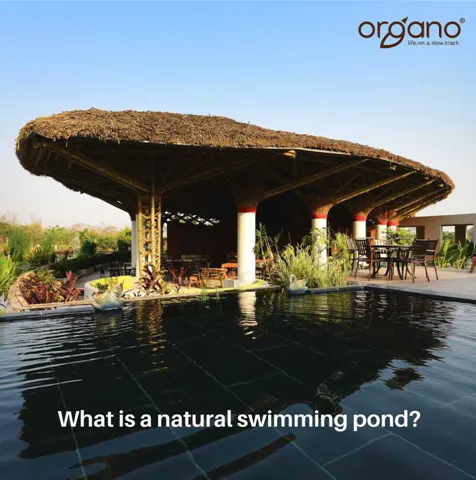 Contact us
Contact usIntent
Community
Studio Organo Concepts
About Us
Subsidaries
Studio Organo
TS RERA No.P02400003403.
TS RERA No.P02400003403.

At Organo, we build natural swimming ponds and not chlorinated pools. These pools are closer to diving into a freshwater lake than into a typical pool. the advantage is that after a refreshing swim, we do not have to worry about taking a bath to wash the chlorine away from the body and it does not leave you with itchy red eyes or dry skin. Along with creating a chemical-free environment, the ponds also act as a habitat for flora and fauna.
Generally, swimming pools try to maintain an algae-free environment by adding different salts and chemicals. A natural pond, on the other hand, is a living aquatic eco-system with a whole range of species co-dependent on each other such as dragonflies, butterflies, frogs, insects, etc.

Water quality is maintained through aquatic plant filters (called Regeneration Zone) and a combination of UV filters, sand filters, and mechanical aeration. These plants in turn act as a habitat for many organisms such as dragonflies, frogs, and insects. Bacteria is also artificially added onto the rock layers where they colonize and help in breaking down organic matter that might accumulate into the system. These bacteria depend on aerobic composition to break down organic matter. That is why mechanical aeration through bubblers is very important. By decomposing organic matter, these bacteria release nutrients which sustain plankton such as Rotifers. These plankton act naturally as algae predators. The plants also help with absorbing these nutrients which further hinder the growth of algae.
Although the bacteria and plants have the ability to absorb organic matter and nutrients, they cannot neutralise pathogens like E-Coli. To do this, the water from the pond is sent through UV filters.
Typically there are three types of plants that are selected: a. floating plants to provide shade and protect the micro-organisms from UV rays
In a natural swimming pond, there will always be algae since it is an ecosystem where different organisms are dependent on each other. Although bacterial colonies and floating & oxygenating plants control the growth of algae


b. oxygenating plants which are typically submerged or free-floating which absorb nitrates and phosphates
c. biological filter plants which absorb nutrients and remove contaminants through their root systems. to some extent, bacteria must be added annually or whenever required. This can be decided based on the pH level of the water
which must be between 5.5 to 7.0.
Skimmers and leaf nets must be used to remove dirt and dead leaves at least once in two days and depending on the usage of the pool, the U V filters must also be replaced once every 3 to 4 years. "Life In an Organic Pond" - By Ashalatha, Naandian. This is a great article written by Naandian, Ashalatha detailing microscopic life in the bio pool at Organo
Naandi. The article also has short videos showing plankton and other micro-organisms in the pond which are essential to keeping the
water free from algae and maintaining the ecosystem in the pond.
